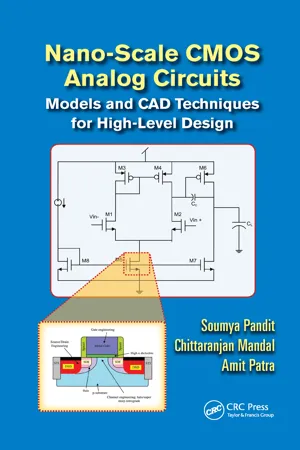
Nano-scale CMOS Analog Circuits
Models and CAD Techniques for High-Level Design
- 408 pages
- English
- ePUB (mobile friendly)
- Available on iOS & Android
Nano-scale CMOS Analog Circuits
Models and CAD Techniques for High-Level Design
About This Book
Reliability concerns and the limitations of process technology can sometimes restrict the innovation process involved in designing nano-scale analog circuits. The success of nano-scale analog circuit design requires repeat experimentation, correct analysis of the device physics, process technology, and adequate use of the knowledge database.
Starting with the basics, Nano-Scale CMOS Analog Circuits: Models and CAD Techniques for High-Level Design introduces the essential fundamental concepts for designing analog circuits with optimal performances. This book explains the links between the physics and technology of scaled MOS transistors and the design and simulation of nano-scale analog circuits. It also explores the development of structured computer-aided design (CAD) techniques for architecture-level and circuit-level design of analog circuits.
The book outlines the general trends of technology scaling with respect to device geometry, process parameters, and supply voltage. It describes models and optimization techniques, as well as the compact modeling of scaled MOS transistors for VLSI circuit simulation.
• Includes two learning-based methods: the artificial neural network (ANN) and the least-squares support vector machine (LS-SVM) method
• Provides case studies demonstrating the practical use of these two methods
• Explores circuit sizing and specification translation tasks
• Introduces the particle swarm optimization technique and provides examples of sizing analog circuits
• Discusses the advanced effects of scaled MOS transistors like narrow width effects, and vertical and lateral channel engineering
Nano-Scale CMOS Analog Circuits: Models and CAD Techniques for High-Level Design
describes the models and CAD techniques, explores the physics of MOS transistors, and considers the design challenges involving statistical variations of process technology parameters and reliability constraints related to circuit design.
Frequently asked questions
Information

Illustration of half-pitch and technology node.
Table of contents
- Cover
- Half Title
- Title Page
- Copyright Page
- Dedication
- Table of Contents
- List of Figures
- List of Tables
- Preface
- About the Authors
- 1 Introduction
- 2 High-Level Modeling and Design Techniques
- 3 Modeling of Scaled MOS Transistor for VLSI Circuit Simulation
- 4 Performance and Feasibility Model Generation Using Learning-Based Approach
- 5 Circuit Sizing and Specification Translation
- 6 Advanced Effects of Scaled MOS Transistors
- 7 Process Variability and Reliability of Nano-Scale CMOS Analog Circuits
- Bibliography
- Index